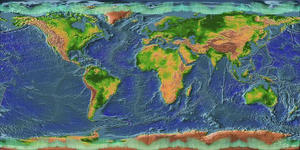Laser pulses to help in creating the most detailed map of California coastline ever assembled
A $3.3 million mapping effort will see researchers in an airplane flying back and forth along the California coast shooting thousands of laser pulses per second at the rocks, beaches, and cliffs along the 1,200-mile shoreline from Mexico to Oregon, generating ultra-detailed 3-D images of the contours of the land in huge computer files; findings could be used to figure out where to build sea walls, or expand wetlands to reduce flooding, or where to move existing development

An example of the high-detail mapping possible with laser mapping techniques // Source: btls.us
In the old days, land surveyors relied on compasses, wooden ships, and parchment. Today, they use laser beams, airplanes, and computer software — at least, these are the tools of scientists who are part of state and federal project to construct the most detailed map of the California coast ever assembled.
The $3.3 million effort will begin with researchers in an airplane flying back and forth along the coast shooting thousands of laser pulses per second at the rocks, beaches and cliffs along the 1,200-mile shoreline from Mexico to Oregon, generating ultra-detailed 3-D images of the contours of the land in huge computer files.
“We need a better sense of what’s out there. We need a modern map. And with a modern map we’ll have the knowledge to make better decisions,” said Doug George, a project manager with the Ocean Protection Council, a state agency in Oakland that approved $2.75 million toward the project last month.
Mercury News’s Paul Rogers writes that the images will be so sharp the map should be able to discern individual boulders and telephone poles, George said. The data will provide a baseline to measure everything from the impact of rising oceans over the coming decades, to beach erosion, to flooding risks from large winter storms.
In addition to the coast, the project will also take images of San Francisco Bay. “This is absolutely cool. I have a picture on my wall of a 1770s map of San Francisco Bay. It looks like the results of a lower digestive tract x-ray,” said Will Travis, executive director of the Bay Conservation and Development Commission, a state agency that regulates development around the bay.
“But from the perspective they had, without aerial photography, it was very reasonable. You look at that next to a USGS map, and you see how much more precise and realistic it is. This is taking it to the next generation.”
Rogers notes that the ocean already has risen eight inches over the past 100 years, as measured by tidal gauges at Fort Point in San Francisco. Computer models run by the Scripps Institution of Oceanography, the U.S. Geological Survey and other research centers predict at the current rate of global warming, sea level could rise another 55 inches — or nearly five feet — by the end of this century as ice sheets continue to melt and the warmer ocean water expands.
The infrared laser beams do not penetrate water well. So researchers hope to combine all the images from land, which will extend inland from the water to about thirty feet in elevation, with other sets of sonar images of the ocean floor that USGS, NOAA and Cal State Monterey Bay have been collecting from boats since 2005.
“Our goal is to have a seamless map of the land and sea,” said George. “That’s the holy grail everyone is looking for to help with research on sea level rise, tsunamis, all kinds of work.”
Rogers writes that findings could be used to figure out where to build sea walls, or expand wetlands to reduce flooding, or where to move existing development. “The next step we want to do is an assessment of vulnerability of various resources to sea level rise — airport runways, Silicon Valley, the Embarcadero in San Francisco, Treasure Island,” said Travis. “And you can’t do that unless you know the exact height of everything.”
